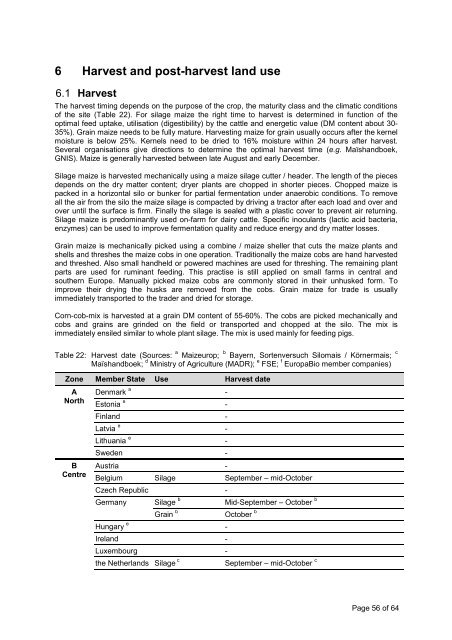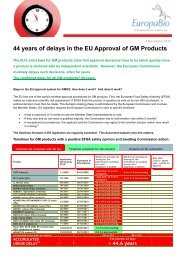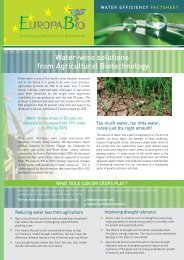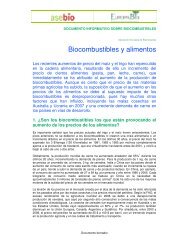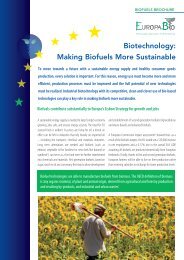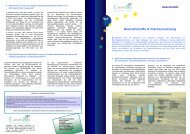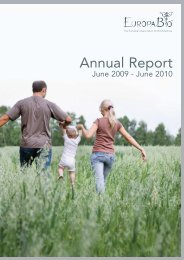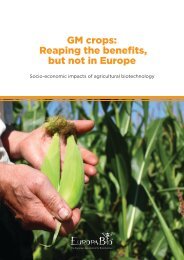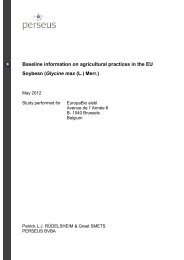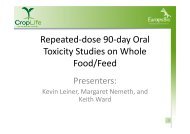Baseline information on agricultural practices in the EU ... - Europabio
Baseline information on agricultural practices in the EU ... - Europabio
Baseline information on agricultural practices in the EU ... - Europabio
Create successful ePaper yourself
Turn your PDF publications into a flip-book with our unique Google optimized e-Paper software.
6 Harvest and post-harvest land use<br />
6.1 Harvest<br />
The harvest tim<strong>in</strong>g depends <strong>on</strong> <strong>the</strong> purpose of <strong>the</strong> crop, <strong>the</strong> maturity class and <strong>the</strong> climatic c<strong>on</strong>diti<strong>on</strong>s<br />
of <strong>the</strong> site (Table 22). For silage maize <strong>the</strong> right time to harvest is determ<strong>in</strong>ed <strong>in</strong> functi<strong>on</strong> of <strong>the</strong><br />
optimal feed uptake, utilisati<strong>on</strong> (digestibility) by <strong>the</strong> cattle and energetic value (DM c<strong>on</strong>tent about 30-<br />
35%). Gra<strong>in</strong> maize needs to be fully mature. Harvest<strong>in</strong>g maize for gra<strong>in</strong> usually occurs after <strong>the</strong> kernel<br />
moisture is below 25%. Kernels need to be dried to 16% moisture with<strong>in</strong> 24 hours after harvest.<br />
Several organisati<strong>on</strong>s give directi<strong>on</strong>s to determ<strong>in</strong>e <strong>the</strong> optimal harvest time (e.g. Maïshandboek,<br />
GNIS). Maize is generally harvested between late August and early December.<br />
Silage maize is harvested mechanically us<strong>in</strong>g a maize silage cutter / header. The length of <strong>the</strong> pieces<br />
depends <strong>on</strong> <strong>the</strong> dry matter c<strong>on</strong>tent; dryer plants are chopped <strong>in</strong> shorter pieces. Chopped maize is<br />
packed <strong>in</strong> a horiz<strong>on</strong>tal silo or bunker for partial fermentati<strong>on</strong> under anaerobic c<strong>on</strong>diti<strong>on</strong>s. To remove<br />
all <strong>the</strong> air from <strong>the</strong> silo <strong>the</strong> maize silage is compacted by driv<strong>in</strong>g a tractor after each load and over and<br />
over until <strong>the</strong> surface is firm. F<strong>in</strong>ally <strong>the</strong> silage is sealed with a plastic cover to prevent air return<strong>in</strong>g.<br />
Silage maize is predom<strong>in</strong>antly used <strong>on</strong>-farm for dairy cattle. Specific <strong>in</strong>oculants (lactic acid bacteria,<br />
enzymes) can be used to improve fermentati<strong>on</strong> quality and reduce energy and dry matter losses.<br />
Gra<strong>in</strong> maize is mechanically picked us<strong>in</strong>g a comb<strong>in</strong>e / maize sheller that cuts <strong>the</strong> maize plants and<br />
shells and threshes <strong>the</strong> maize cobs <strong>in</strong> <strong>on</strong>e operati<strong>on</strong>. Traditi<strong>on</strong>ally <strong>the</strong> maize cobs are hand harvested<br />
and threshed. Also small handheld or powered mach<strong>in</strong>es are used for thresh<strong>in</strong>g. The rema<strong>in</strong><strong>in</strong>g plant<br />
parts are used for rum<strong>in</strong>ant feed<strong>in</strong>g. This practise is still applied <strong>on</strong> small farms <strong>in</strong> central and<br />
sou<strong>the</strong>rn Europe. Manually picked maize cobs are comm<strong>on</strong>ly stored <strong>in</strong> <strong>the</strong>ir unhusked form. To<br />
improve <strong>the</strong>ir dry<strong>in</strong>g <strong>the</strong> husks are removed from <strong>the</strong> cobs. Gra<strong>in</strong> maize for trade is usually<br />
immediately transported to <strong>the</strong> trader and dried for storage.<br />
Corn-cob-mix is harvested at a gra<strong>in</strong> DM c<strong>on</strong>tent of 55-60%. The cobs are picked mechanically and<br />
cobs and gra<strong>in</strong>s are gr<strong>in</strong>ded <strong>on</strong> <strong>the</strong> field or transported and chopped at <strong>the</strong> silo. The mix is<br />
immediately ensiled similar to whole plant silage. The mix is used ma<strong>in</strong>ly for feed<strong>in</strong>g pigs.<br />
Table 22: Harvest date (Sources: a Maizeurop; b Bayern, Sortenversuch Silomais / Körnermais; c<br />
Maïshandboek; d M<strong>in</strong>istry of Agriculture (MADR); e FSE; f EuropaBio member companies)<br />
Z<strong>on</strong>e Member State Use Harvest date<br />
A<br />
North<br />
B<br />
Centre<br />
Denmark a<br />
Est<strong>on</strong>ia e -<br />
F<strong>in</strong>land -<br />
Latvia e -<br />
Lithuania e<br />
Sweden -<br />
Austria -<br />
Belgium Silage September – mid-October<br />
Czech Republic -<br />
Germany Silage b Mid-September – October b<br />
Hungary e<br />
Gra<strong>in</strong> b October b<br />
Ireland -<br />
Luxembourg -<br />
<strong>the</strong> Ne<strong>the</strong>rlands Silage c September – mid-October c<br />
-<br />
-<br />
-<br />
Page 56 of 64


